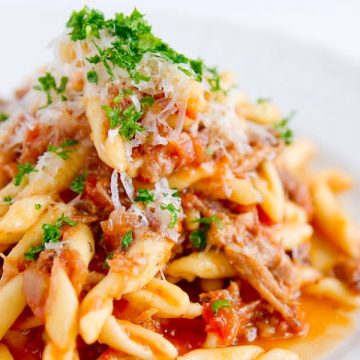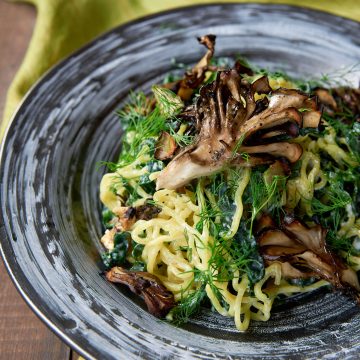
Fall is one of my favorite seasons. The golden sunsets cast long shadows, vermillion leaves scurry around in circles carried by the brisk autumn breeze, and in the kitchen, it's the season of slow-cooked melt-in-your-mouth roasts and home warming braises.
Perhaps it's driven by some primal nesting instinct, but as the thermostat falls, I yearn to stock up and hunker down. My freezer gets loaded up with meat, and my pantry is brimming with canned goods in preparation for a long winter. It's also around this time that my Le Creuset emerges from hibernation and makes it's first appearance of the season.

This sugo is the perfect dish to make on one of those chilly days when your toes wince upon hitting the floorboards as you emerge from bed in the morning. It's a simple affair that involves some meat, a little wine and a lot of time. But just because something takes a long time to cook doesn't mean it requires a lot of your time.

Beyond some dicing and browning, there's not a whole lot to do, so you can go right ahead and jump back into bed! A few hours later, you'll be rewarded by a luscious sauce with tender bits of pork that melt into a pool of rich meaty flavor with each bite. I like pairing this sugo with Strozzapreti because it has a wonderful firm texture that skirts the boundary of tender and chewy. It stands up to the hearty sauce while absorbing all it's flavors, all without going limp. It's also delicious on Malfatti, gnocchi's less attractive cousin, and one of my favorite childhood Italian dishes.
This recipe first appeared on norecipes.com but due to its age I've moved it here to my personal recipe archive. Check out the full No Recipes Archives for more older recipe or check out some of my favorite recipes.

Units
Ingredients
- 1 tablespoon vegetable oil
- 680 grams pork shoulder
- 2 large cloves garlic (minced)
- 1 medium onion (diced)
- ½ carrot (small dice)
- ⅔ cup red wine
- 3 cups tomatoes (peeled, seeds removed and chopped)
- 1 bay leaf
- 3 sprigs fresh thyme
- 450 grams Strozzapreti (or other short pasta, boiled according to package directions)
- Parmigiano-Reggiano (for serving)
Instructions
- Generously salt and pepper the 680 grams pork shoulder. Heat a heavy pot just large enough to fit the pork over medium heat. Add the 1 tablespoon vegetable oil, then add the pork. Fry until golden brown, turning until golden brown on all sides. The browned bits lay the foundation for our sugo.
- Transfer the pork to a plate, drain off all but 1 tablespoon of oil, then add the 2 large cloves garlic, 1 medium onion, and ½ carrot. Sauté the vegetables until they start browning. This sweetens them and adds another layer of flavor on top of the browned pork.
- Add the ⅔ cup red wine and bring to a boil. You want to scrape all the browned bits off the bottom of the pan and burn off the alcohol in the wine. Add the 3 cups tomatoes, 1 bay leaf and 3 sprigs fresh thyme into the pot along with the pork. Make sure the pork is mostly submerged, then cover loosely with a lid (leave the lid ajar). Turn down the heat to low and simmer for about 3 hours or until you can easily stick a fork into the pork. You'll want to flip the pork a few times if it is not completely covered in sauce.
- When the pork is tender, remove it from the pot and use a fork to shred the meat. Use a spoon to skim off any excess fat (a little is okay, but you don't want an oil slick on top). Add the pork back to sauce, which should now be pretty thick. If it's watery, turn up the heat a bit and reduce it until it's nice and thick.
- Boil the 450 grams Strozzapreti just short of the time specified on the package. Drain and add to the sugo. Turn up the heat and cook for a few minutes until the strozzapreti is al dente and the sauce easily coats each piece of pasta. Serve with some grated Parmigiano-Reggiano.

















Comments
No Comments